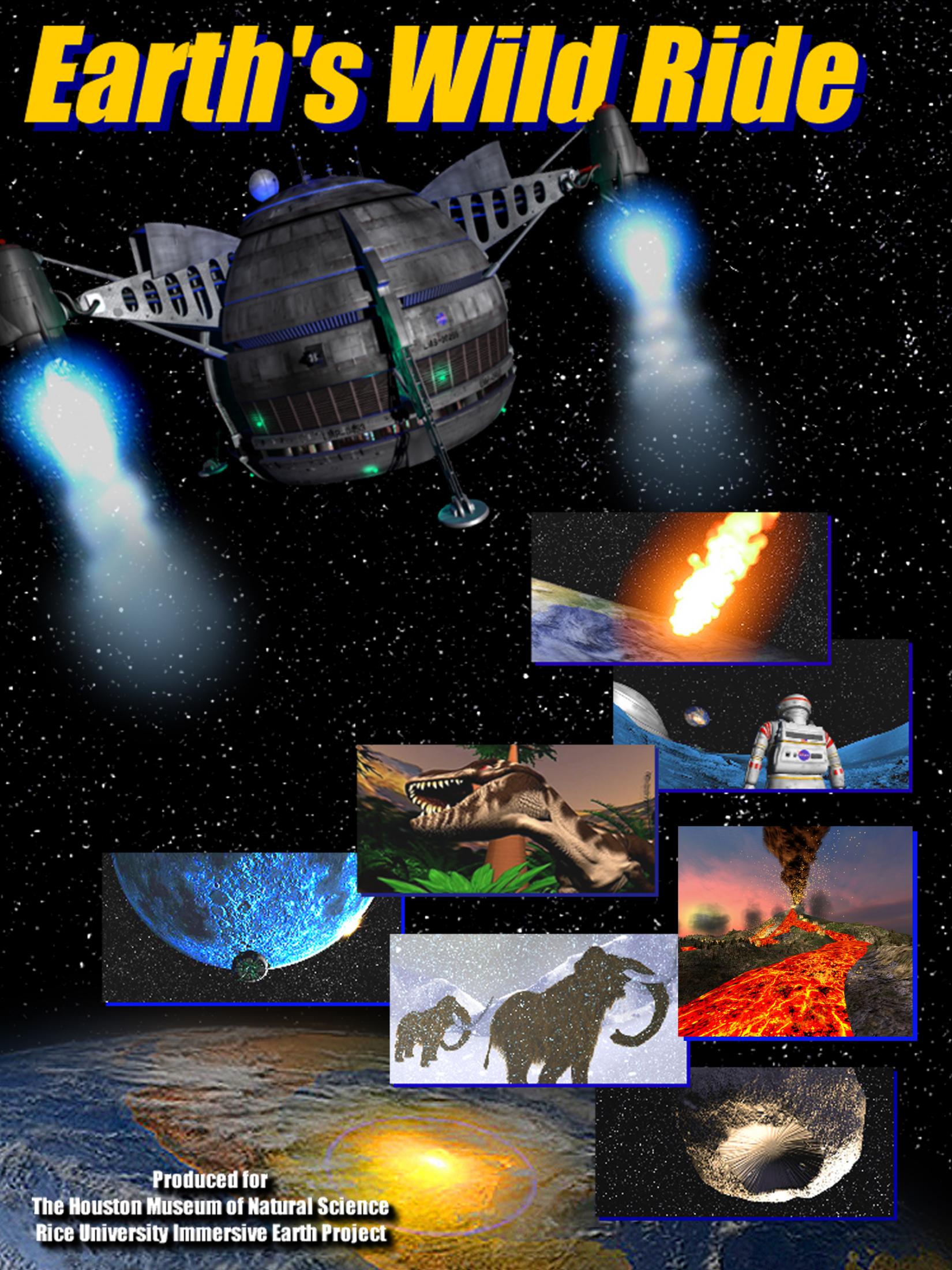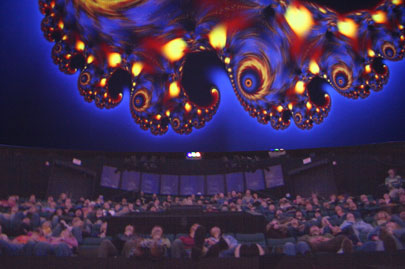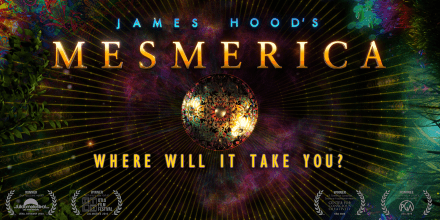The Museum is currently closed for renovations. Updates on the renovation will be available here and on the Museum's social media pages. More information about the project is available HERE.
You are here
Planetarium: Information for School Groups
School groups are always welcome at any of the planetarium's regularly scheduled shows, but the planetarium is also pleased to offer special shows for groups of at least 15 by request. Generally the theater is available at 10 a.m. every day or by request between other shows for any offering seen here.
For questions about availability, please fill out the Schoolgroup Reservation Form or contact Group Bookings at (505) 527-1663
About our Shows
Every planetarium show comes with a live component! Enchanted Skies is our full-length live show, but all of the movies below also have a short, 15-20 minute live presentation included before they start.
Any request for content and educational needs or goals made at the time of registration will be integrated into shows when possible.
Available Planetarium Shows
 Imagine Earth were a distant place you once called home but could never visit again. What would you remember most about the planet, and how would you describe it to your grandchildren?
Imagine Earth were a distant place you once called home but could never visit again. What would you remember most about the planet, and how would you describe it to your grandchildren?
Set on the surface of the Moon in the year 2081, a grandfather and granddaughter watch a solar eclipse from scenic cliffs overlooking their moon colony. Conversation leads to contrasts between the moon, the only home the granddaughter knows, and the Earth, where the grandfather has spent most of his life.
As they watch the Moon's shadow move across Earth, the grandfather tells stories of crashing asteroids, erupting volcanoes, roaring dinosaurs, electrifying lightning and booming thunder. Each experience begins with a telescope view of the dynamic Earth in stark contrast with the unchanging lunar landscape.
Earth's Wild Ride is like many tales shared by grandparents over the centuries, except "the old country" is really another planet, always visible from the moon base, but totally unlike the granddaughter's world. While learning about eclipses, the ice age, Earth's water cycle and differences between the Earth and Moon, the audience is taken on a roller-coaster-like ride through canyons of raging rivers and hot flowing lava. Adventure and appreciation for home fill this journey back to the Earth.
Produced in collaboration with Rice University, through NASA's Immersive Earth Project.
 Special fractal shows for groups can only be scheduled by contacting the Fractal Foundation first using the information below. These programs also require a special fee above what is charged for all other planetarium shows.
Special fractal shows for groups can only be scheduled by contacting the Fractal Foundation first using the information below. These programs also require a special fee above what is charged for all other planetarium shows.
The Fractal Foundation is now offering their spectacular, award-winning full-dome planetarium shows for school groups. This 50-minute show takes viewers on a tour of the fractals in nature and zooms through infinitely complex mathematical fractals. Featuring original music, the show is both educational and highly entertaining. To schedule a fractal show for your group and learn about pricing, contact jonathan@fractalfoundation.org or 505-489-3393.
 Explore the never-ending world of fractals in this award-winning and inspiring planetarium program. The shows take audiences on a journey through the infinitely complex patterns known as fractals. This live, narrated show explores the fractal patterns in nature as well showing how math can become incredibly beautiful. The abstract landscapes that emerge from simple equations inspire fascination and wonder as they bring us face to face with the infinite.
Explore the never-ending world of fractals in this award-winning and inspiring planetarium program. The shows take audiences on a journey through the infinitely complex patterns known as fractals. This live, narrated show explores the fractal patterns in nature as well showing how math can become incredibly beautiful. The abstract landscapes that emerge from simple equations inspire fascination and wonder as they bring us face to face with the infinite.
Shows frequently sell out. Purchase tickets in advance from the Fractal Foundation
The immensity and power of black holes inspire wonder and curiosity. As we consider these stellar enigmas, the very nature of space time is warped as we approach. The mass of a large star has collapsed and compressed into an area so small that space and time have no meaning within its bounds. Our journey also visits super-massive black holes of unfathomable size at the central point of galaxies. These hidden monsters constrain their entire galaxies around them in a kaleidoscopic gravitational dance. Voyage through the galaxies in search of the answers to explain these riddles of nature in , Black Holes! Narrated by John de Lancie. Suitable for: 4th Grade and Up
For thousands of years the humans observed the light coming from the night sky with their eyes. In the beginning of the 17th century, the invention of the telescope by Galileo revolutionized our knowledge of the Universe. Finally, in the 20th century with the advent of rockets, it became possible to go above the earth’s atmosphere and observe X-ray and gamma ray radiation which are the marks of the hot and violent Universe. But it is not only light that can give us information about the cosmos. Neutrinos and cosmic rays also provide vital information. Finally, the detection by the LIGO experiment of gravitational waves from two merging black holes opened a new window in astrophysics. This video presents images of the cosmos as revealed by all these different messengers. Suitable for: 6th Grade and Up
Leading scientists in observational and theoretical studies of black holes and galaxies, industrial experts in cutting-edge big technologies, and professionals in science dissemination have been brought together to set up research projects which will combine the latest state-of-the-art observations, numerical simulations and innovative analytic tools to compare theory with observation, and shed light on the physics of black hole formation in the context of galaxy evolution. This planetarium show presents the environments of the black holes in an impressive and understandable way to the audience. Suitable for: 6th Grade and Up
The Dark Energy Spectroscopic Instrument (DESI) is creating the most detailed map of our nearby universe. Installed on the Mayall telescope on Kitt Peak in Southern Arizona, DESI's 5000 independently operated robots can measure the light from thousands of galaxies at once. Join us as we explore the science, instrument, and people behind this global endeavor. Suitable for: 6th Grade and Up

Mesmerica 360 is a fully immersive music and art cinematic projection show. This experience blends the atmospheric music of James Hood with visually stunning graphics and imagery. Mesmerica is presented in the planetarium on select Friday evenings. For more information, a schedule, and ticket purchases, go to: tickets.mesmerica.com/albuquerque.
To book a private group showing, please contact sales@mesmerica.com. Once a price quote is sent from Mesmerica, a museum representative will contact you to verify the date and time, and schedule any other activities at the museum.
Mesmerica is a separate organization from the museum, so tickets can only be purchased through their website or in person on the night of the shows, based on availability. Inquiries should be sent to boxoffice@jameshood.com.

Ever wonder what it would be like to fly to Mars? NASA – and others – have their sights set on the Red Planet and they’re building the technology to get us there! Destination Mars: The New Frontier gives you an up-close look at humanity’s most epic endeavor.
Explore the work being done around the globe to help make the dream of getting humans to Mars a reality. Fly through the International Space Station, where astronauts are already living and working in space, and follow the rockets and vehicles that will take humans beyond the Moon and, one day, all the way to Mars! Travel along as we imagine this remarkable journey.
 Messengers of Time and Space invites audiences to explore the dynamic cosmos and witness the transformative impact of real-time data on our understanding of celestial phenomena. This show visits several instruments studying outer space in different ways, from the Gemini North Observatory to the Laser Interferometer Gravitational-wave Observatory.
Messengers of Time and Space invites audiences to explore the dynamic cosmos and witness the transformative impact of real-time data on our understanding of celestial phenomena. This show visits several instruments studying outer space in different ways, from the Gemini North Observatory to the Laser Interferometer Gravitational-wave Observatory.
Messengers weaves a story that looks back at humanity’s long history with a changing night sky. It explores how our perspective on the dynamic Universe is being revolutionized by observations of energy and forces. Highlighted discoveries include the extrasolar interloper ‘Oumuamua and powerful kilonova collisions/explosions that literally rattle space with gravitational waves.
Over 50 years ago the first human walked on the moon during the Apollo program. CAPCOM Go! describes the story behind this historic moment to inspire the next generation of explorers and dreamers.
The Little Star That Could is a story about Little Star, an average yellow star in search for planets of his own to protect and warm. Along the way, he meets other stars, learns what makes each star special, and discovers that stars combine to form star clusters and galaxies. Eventually, Little Star finds his planets. Each planet is introduced with basic information about our solar system.
The Little Star That Could was originally created by the Saint Louis Science Center and reproduced by Audio Visual Imagineering and Brevard Community College.
Come to this program with any questions you may have about astronomy. During this live, interactive show, audience members are asked what they are interested in learning about the sky and that influences what is discussed. The presenters will do their best to not only answer your questions but illustrate with available visuals on the dome.
Kari Byron from Crash Test World and MythBusters launches us on a journey beyond the Earth towards a sustainable future in space. NASA’s 21st-century Artemis program, named for the Greek goddess of the moon and twin of Apollo, is the next step in our endeavor to explore the universe and land the first woman and person of color on the surface of the moon. The planetarium feature is produced by Fiske Planetarium in collaboration with TEND Studio with funding from NASA SSERVI and Lockheed Martin.
Narrated by George Takei, our award-winning planetarium show explores asteroids, comets, and the hard-hitting stories of our cosmic origins.
Embark on a journey back in time and across the Solar System, following the paths of asteroids and comets that have collided with Earth—and those that roam far from home. These ancient objects travel billions of years before reaching Earth, and their impact can be so powerful that just one collision can change the course of life on our planet.
Scientists aren't waiting for asteroids and comets to come to us to learn more about them—get an up-close look at spacecraft sent to rocky asteroids and icy comets to collect invaluable data. You’ll follow the trek of the Chelyabinsk meteor as it entered the Earth's atmosphere in 2013 and visualize major shifts in the history of the Solar System billions of years in the making—and all in under an hour.
How did life on Earth begin? Take a high-speed tour of key events since the Big Bang that set the stage for life. Starting with the first stars and ending with the tremendous biological diversity on Earth today, Life: A Cosmic Story shows how the human pedigree is actually 13.7 billion years in the making. Narrated by Oscar-winning actress Jodie Foster.

Join a family of space aliens as they tour our solar system in search of the ideal vacation destination. Along the way, learn interesting facts about all of the planets and even some moons.
Phantom of the Universe reveals the first hints of dark matter's existence through the eyes of Fritz Zwicky, the scientist who coined the term "dark matter." It describes the astral choreography witnessed by Vera Rubin in the Andromeda galaxy and then plummets deep underground to see the most sensitive dark matter detector on Earth, housed in a former gold mine.
From there, the show journeys across space and time to the Large Hadron Collider at CERN, speeding alongside particles before they collide in visually stunning explosions of light and sound, while learning how scientists around the world are collaborating to track down the constituents of dark matter. Narrated by Academy Award winner Tilda Swinton.
Sunstruck is a journey to discover the wonders of our magnificent sun and investigate how our star has supported life on Earth for millennia. This program includes information on the structure of our sun, the source of its energy, and how solar activity impacts our world.
This show explores the relationship between the Earth, Moon and Sun with the help of Coyote, an amusing character adapted from Native American oral traditions who has many misconceptions about our home planet and its most familiar neighbors.
His confusion about the universe makes viewers think about how the Earth, Moon and Sun work together as a system. Native American stories are used throughout the show to help distinguish between myths and science.
In a feast of colors and sounds, Mayan Archaeoastronomy: Observers of the Universe intertwines science and mythology on a poetic journey describing the way Mayans viewed and understood the Universe.
The movie includes a tour of six Mayan temples, including San Gervasio, Chichen Itzá, Uxmal, Edzná, Palenque, and Bonampak. The importance of the temple’s orientation in relation to the movements of the Sun, Moon, and Venus is vividly depicted.
The film financed by the National Council of Science and Technology of Mexico, produced by Frutos Digitales with the support of the European Southern Observatory (ESO).



